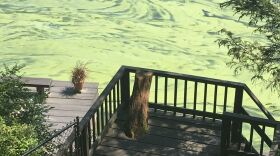The Wallkill River Watershed Alliance is holding its fifth annual Wallkill River Summit Thursday night at SUNY New Paltz.
The theme of the summit is “How’s the Water?” Brian Duffy is program manager of the New York state Department of Environmental Conservation’s Stream Bio-monitoring Unit.
“The presentation that I’m going to give tonight is going to focus mainly on the nutrient concentrations that we see across the watershed that have been, as you mentioned, manifested as harmful algal blooms over the last couple of years, particularly going back to 2016, when we had the extensive harmful algal bloom across the lower 30 miles or so of the Wallkill,” says Duffy.
This also has been the subject of monitoring the past few years. The Wallkill River was not part of Harmful Algal Bloom Action Plans unveiled in 2018 for 12 priority waterbodies. Duffy says DEC is coming up with a plan.
“Yeah, well, a big part of the step over the last couple of years has been documenting the issue. So it’s one thing to see the harmful algal blooms, but a big part in that process, in the science-based planning process, is to document the issues with data. And that’s why we’ve been focusing on the collection of the nutrient information, particularly with a focus on phosphorous,” says Duffy. “And, as part of that, DEC, at this point, is initiating the TMDL process. So it’s a watershed plan to start to address and make science-based decisions about how we’re going to address the nutrient issue that we’re seeing across the basin.”
TMDL stands for total maximum daily load, in this case, phosphorous, a type of Clean Water Plan to develop a strategy toward water quality improvement.
“And we’re developing a plan to address the water quality issues that are being manifested as a result of the phosphorous concentrations that we’re seeing across the basin,” says Duffy.
This is welcome news to Dan Shapley. He’s water quality program director for Riverkeeper.
“The big news is really that the DEC is not only doing this extensive monitoring that they have committed to over the last couple of years, but now it’s committing to a clean water plan for the Wallkill River, which will really move us to a whole next phase in the restoration of the river,” Shapley says.
He says such a plan moves closer to an action level to clean up the river. Riverkeeper is presenting data at the summit, on bacteria considered a reliable indicator of fecal contamination, data going back to 2012. Shapley says in understanding the data, Riverkeeper is looking to novel approaches and priorities for cleaning up the river.
“So some of the priorities that our data have identified include a failing pump station in the Village of Walden, which we see very frequently in rains is overflowing into the river, also include the Village of Florida, which has a treatment plant that doesn’t use modern disinfection techniques,” says Shapley. “So those are among the priorities that we’ve been able to identify with our data and our look at the infrastructure in the watershed to really see as particularly high priorities for remediation sooner than later.”
How a cool, rainy spring, or other weather conditions could impact harmful algal blooms is something the DEC’s Duffy says they are trying to figure out.
“We have installed stream gauges throughout the Wallkill. The United States Geological Survey has installed their stream gauge at a couple of additional locations throughout the Wallkill,” Duffy says. “And I think that, those are the kind of questions that we’re looking to answer in the research that’s been done in the Wallkill and across the state is what exactly are those conditions that generate the potential for harmful algal blooms.
He says there already was one gauge operating, and two were added in 2018.
In the past five years, state and local communities have committed $36 million to improve sewer systems in the watershed in Orange and Ulster Counties, including projects in Middletown, Wallkill, the Village of Warwick and Village of New Paltz.








